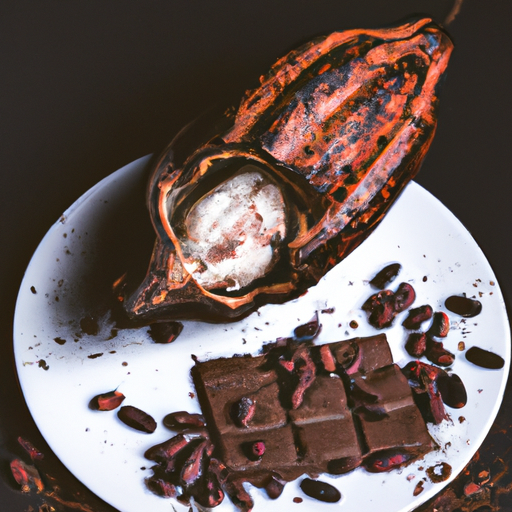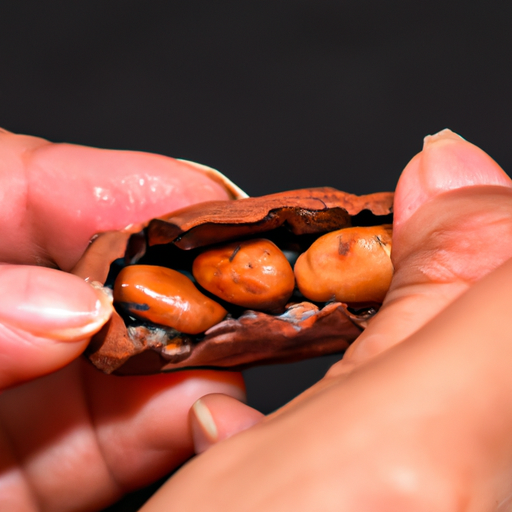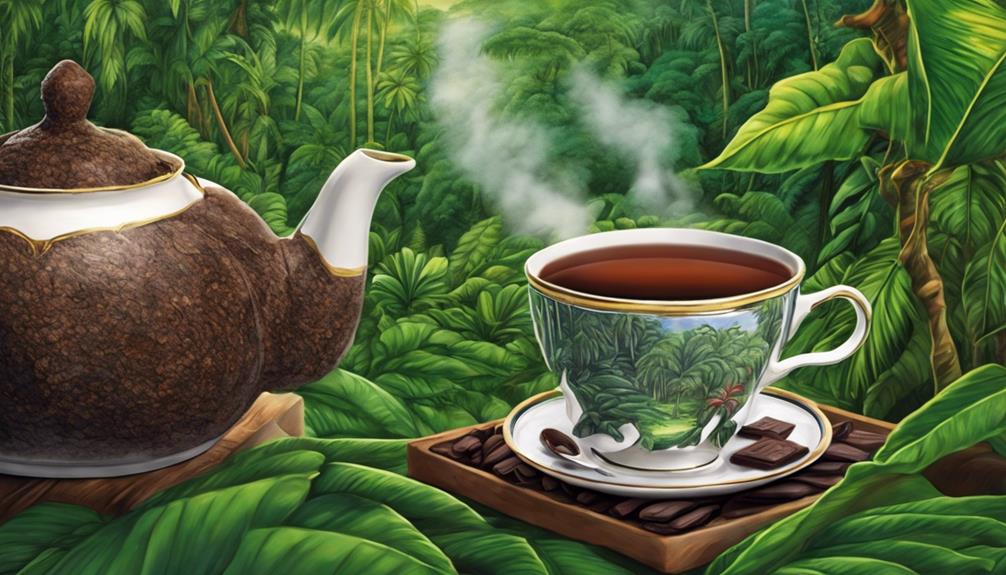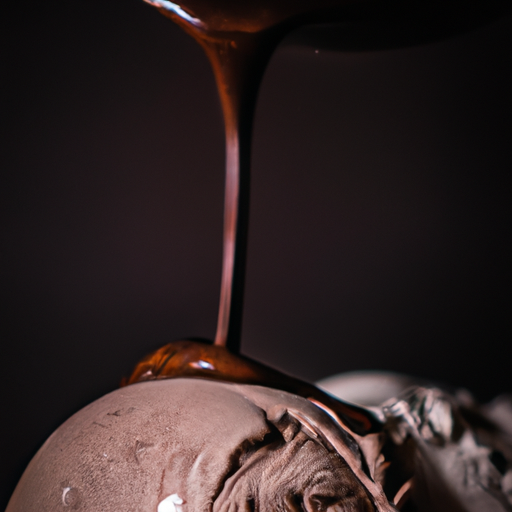Have you ever experienced the taste of pure magic? That’s how raw cacao feels to me. Once it meets my palate, a delightful array of flavors starts to tango on my taste buds, captivating my senses with its bitter and earthy essence.
Raw cacao is a true delicacy, a gift from nature that holds a complexity unlike any other food I have encountered. It is the essence of indulgence, offering a richness that is both comforting and exhilarating.
But raw cacao is not just about its heavenly taste. It is also packed with incredible nutritional benefits, making it a guilt-free pleasure. From boosting mood and energy to providing a wealth of antioxidants, this superfood has it all.
In this article, we will dive deep into the world of raw cacao, exploring its origins, discussing the difference between raw cacao and processed chocolate, and uncovering the secrets of its taste.
Get ready to embark on a journey of flavor and discovery as we unravel the wonders of raw cacao.
Key Takeaways
- Complex and luxurious flavors
- Rich and intense taste
- Deep, earthy flavor with subtle notes of bitterness and natural sweetness
- Slight nuttiness and a complex, layered taste
The Origins of Raw Cacao
Raw cacao, with its rich and earthy flavor, can be traced back to the ancient civilizations of Mesoamerica. Cultivation practices of raw cacao were highly revered by these civilizations, who believed it to be a sacred and divine plant. They cultivated cacao trees in tropical regions, carefully nurturing the delicate pods that held the precious cacao beans inside.
The historical significance of raw cacao cannot be overstated, as it played a central role in the rituals, economy, and social fabric of these civilizations. The process of cultivating, harvesting, and preparing raw cacao was a meticulous art form passed down through generations. It is this ancient wisdom and reverence that gives raw cacao its unique and distinct taste, a flavor that transports you back in time.
Now, let’s explore the difference between raw cacao and processed chocolate.
The Difference Between Raw Cacao and Processed Chocolate
Contrary to processed chocolate, raw cacao offers a distinct flavor profile. The difference lies in the processing. Here are some key points to note about the distinction between raw cacao and processed chocolate:
- Raw cacao maintains its natural state, while processed chocolate undergoes various refining processes.
- Raw cacao retains its vibrant and intense flavor, whereas processed chocolate tends to have a milder taste.
- The processing of chocolate involves roasting, which can alter the flavor and reduce some of the natural bitterness found in raw cacao.
- Raw cacao has a more complex and nuanced taste, with hints of fruitiness, floral notes, and even a slight nuttiness.
Now, let’s delve into the bitter and earthy flavor profile of raw cacao.
The Bitter and Earthy Flavor Profile of Raw Cacao
Indulging in a bite of raw cacao is like taking a journey through a dense forest, as its bitter and earthy flavor transports you to a realm of rich, dark flavors. The bitterness of raw cacao is intense, yet intriguing. It coats your tongue with a robust and deep sensation, awakening your taste buds to a symphony of flavor notes. As you savor this raw delight, you can detect hints of nuttiness and a subtle sweetness that lingers in the background. The bitterness is balanced by the earthiness, creating a harmonious blend that is both bold and natural.
To illustrate the complexity of raw cacao’s taste, let’s explore a table that captures its flavor profile:
| Flavor Notes | Description |
|---|---|
| Bitter | Intense and robust, coats the tongue |
| Nutty | Subtle hints of nuts |
| Earthy | Harmonious blend of natural flavors |
| Sweet | Mellow sweetness in the background |
As we delve into the subsequent section about the complexity of raw cacao’s taste, we will uncover even more fascinating aspects of this culinary treasure.
The Complexity of Raw Cacao’s Taste
Prepare to embark on a flavor journey like no other, as the intricate taste of raw cacao takes you on a wild ride through a world of bitter intensity and harmonious earthiness.
Raw cacao’s taste is a testament to its complexity, offering a sensory experience that is truly remarkable. As the velvety richness envelops your taste buds, you’ll discover layers of flavors that dance together in perfect harmony.
The initial bitterness is balanced by subtle notes of fruity sweetness and a hint of nuttiness. It’s a delicate balance that only raw cacao can achieve, captivating your palate with every bite.
This intricate taste profile is what sets raw cacao apart from other chocolates, making it a truly unique and indulgent experience.
Now, let’s delve into the nutritional benefits of raw cacao, and uncover the wonders it holds for our well-being.
The Nutritional Benefits of Raw Cacao
One cannot deny the immense nutritional benefits that raw cacao brings to our well-being.
Not only does it satisfy our taste buds with its rich and complex flavor, but it also packs a powerful punch of health advantages.
Raw cacao is a powerhouse of antioxidants, which help fight against free radicals and reduce the risk of chronic diseases.
It is also a great source of magnesium, iron, and fiber, all of which are essential for maintaining a healthy body.
Additionally, raw cacao contains compounds that can boost mood and improve cognitive function.
With all these nutritional benefits, it’s no wonder that raw cacao has gained popularity as a superfood.
So, let’s move on to the next section and discover some tips for enjoying raw cacao.
Tips for Enjoying Raw Cacao
If you’re looking to enhance your culinary experiences, there are numerous ways to savor the delightful flavors of raw cacao. Here are some tips to make the most of this delectable ingredient:
-
Start with small quantities: Raw cacao has a rich and intense flavor, so it’s best to start with small amounts and gradually increase as you become accustomed to its taste.
-
Experiment with different recipes: Raw cacao can be used in a variety of dishes, from smoothies and desserts to savory dishes like mole sauce. Don’t be afraid to get creative and try new recipes.
-
Pair it with complementary flavors: Raw cacao has a slightly bitter taste, so pairing it with sweet ingredients like dates, honey, or maple syrup can help balance the flavors.
-
Use it as a topping: Sprinkle raw cacao nibs on top of your favorite desserts or add them to granola, yogurt, or smoothie bowls for a crunchy and indulgent twist.
By following these tips, you can fully enjoy the unique benefits and flavors of raw cacao.
Now, let’s explore how to pair raw cacao with other flavors for even more culinary delights.
Pairing Raw Cacao with Other Flavors
Get ready to embark on a flavor adventure as we explore how to perfectly pair the rich and intense raw cacao with other delightful flavors.
When it comes to flavor combinations, the possibilities are endless. Raw cacao has a deep and complex taste that can be enhanced by a variety of ingredients.
For those who prefer a bold and intense experience, pairing raw cacao with flavors like chili, espresso, or even smoky spices can create a truly sensational combination.
On the other hand, if you have a sweet tooth, pairing raw cacao with fruits like raspberries, bananas, or oranges can add a refreshing and fruity twist to the rich chocolate flavor.
Whatever your taste preferences may be, experimenting with different flavor pairings is sure to elevate your raw cacao experience to new heights.
Now, let’s dive into exploring recipes and dishes with raw cacao.
Exploring Recipes and Dishes with Raw Cacao
Indulge yourself in a decadent culinary journey by exploring a variety of mouthwatering recipes and dishes that showcase the irresistible allure of raw cacao.
From rich and velvety chocolate smoothies to heavenly raw cacao truffles, the possibilities are endless when it comes to incorporating this superfood into your culinary creations.
Not only does raw cacao add a deep and intense chocolate flavor to your dishes, but it also boasts a range of health benefits. Packed with antioxidants, minerals, and mood-enhancing compounds, raw cacao can contribute to a healthy heart, improved cognitive function, and a boost in serotonin levels.
So why not treat yourself to a guilt-free indulgence that not only tantalizes your taste buds but also nourishes your body?
As we delve into the final thoughts on the taste of raw cacao, prepare to be captivated by its complex and luxurious flavors.
Final Thoughts on the Taste of Raw Cacao
As I savor the last bite of a velvety smooth raw cacao truffle, the intricate blend of flavors dances across my palate, leaving behind a lingering sensation of pure decadence. Raw cacao has a distinct taste that is both rich and intense. It possesses a deep, earthy flavor with subtle notes of bitterness and a hint of natural sweetness. The taste is complex and layered, with a slight nuttiness that adds depth to every bite.
Beyond its delicious taste, raw cacao also offers numerous health benefits. It is packed with antioxidants, which can help reduce inflammation and protect against oxidative damage. Additionally, raw cacao contains minerals like magnesium and iron, which are essential for overall well-being.
Furthermore, raw cacao holds a significant cultural significance. It has been used for centuries in various ancient civilizations as a sacred ingredient in rituals and ceremonies. The Mayans and Aztecs believed that raw cacao was a divine gift from the gods and valued it highly. Today, raw cacao continues to be cherished and celebrated in many cultures around the world.
In conclusion, the taste of raw cacao is a truly remarkable experience. Its complex flavors and health benefits make it a delightful treat that can be enjoyed guilt-free. So, indulge in the decadence of raw cacao and discover the wonders it has to offer.
Frequently Asked Questions
How is raw cacao harvested and processed?
I’ll give you the lowdown on how raw cacao is harvested and processed. Farmers delicately pluck ripe cacao pods from trees, carefully extract the seeds, ferment and dry them, then roast and grind to create the rich, flavorful raw cacao we all love.
Can raw cacao be used as a substitute for cocoa powder in baking?
Raw cacao can be used as a substitute for cocoa powder in baking. It has a rich, intense flavor compared to cocoa powder and adds a unique depth to baked goods. The texture may be slightly different, but it still produces delicious results.
Are there any potential health risks associated with consuming raw cacao?
When it comes to consuming raw cacao, there are potential health risks to consider. However, it also offers numerous potential health benefits. To ensure high quality, choose products that are organic, non-GMO, and minimally processed.
What are some popular ways to incorporate raw cacao into a daily diet?
I love incorporating raw cacao into my daily diet! I enjoy trying out creative raw cacao recipes like smoothie bowls, energy balls, and homemade chocolate bars. Plus, the benefits for brain health make it even more enticing.
Is there a recommended amount of raw cacao to consume for maximum health benefits?
There is a recommended daily intake of raw cacao for maximum health benefits. It is important to note that raw cacao is different from cocoa powder, as it is less processed and retains more nutrients.
What Does Raw Cacao Taste Like Compared to Cocoa?
Raw cacao versus cocoa: Raw cacao has a more intense and slightly bitter taste compared to cocoa. It has a richer, deep chocolate flavor with subtle fruity and nutty notes. Cocoa, on the other hand, is milder and sweeter, with a more familiar chocolatey taste.
Conclusion
As I conclude my exploration of the taste of raw cacao, I am left in awe of its complexity and richness.
Raw cacao’s flavor, with its bitter and earthy undertones, is like a symphony playing on your taste buds.
It dances between sweetness and intensity, leaving a lingering sensation of indulgence.
Just as a painter blends colors to create a masterpiece, raw cacao blends flavors seamlessly, creating a sensory experience like no other.
So go ahead, indulge in the world of raw cacao, and let your taste buds embark on a delectable adventure.










